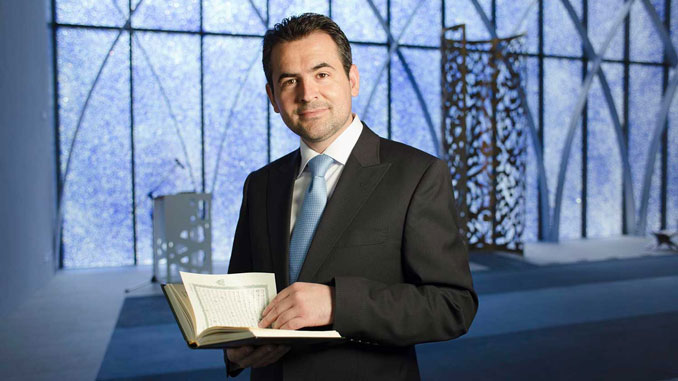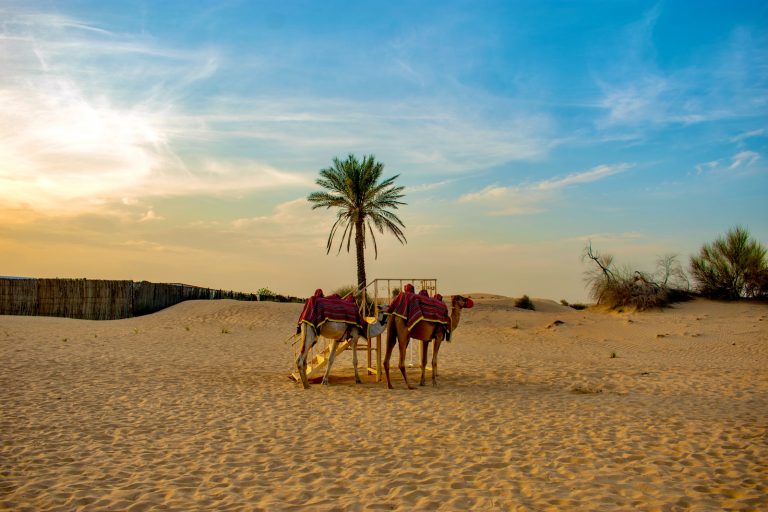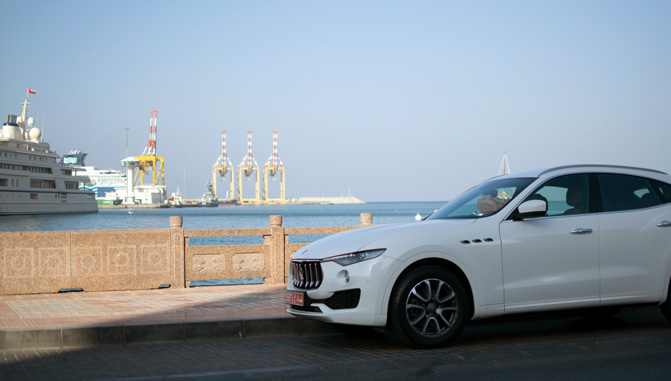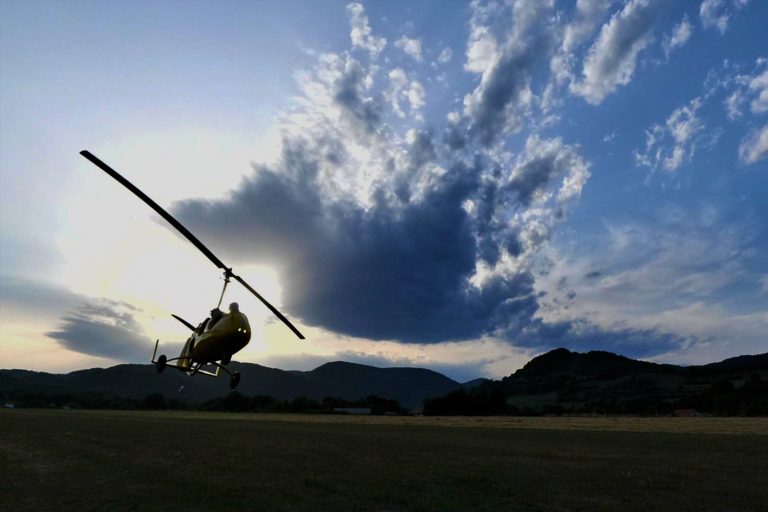Muscat – from the splendor of the Sultan’s palaces and the pulse of the Omani Renaissance
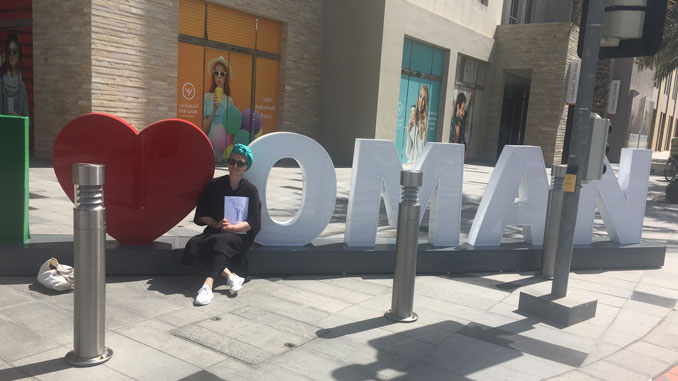
Have you ever thought about what exactly it is that gives a face to the magic of the Orient? Perhaps these thoughts will cause bubbles to pop up in your mind’s eye, reflecting your dust-covered children’s book dreams. Use your newfound wisdom as an adult that even children’s books come with a large dose of reality and make your childhood dreams come true, following the star of the South to the fairytale Orient.
In Muscat, the capital of the Sultanate of Oman, the artifacts of the ages merge with the modern madness of a vibrant life in the heart of metropolitan city culture. Witness how, in the face of architectural masterpieces, the energy of Oman‘s economic center combines with the human kindness of Omanis to create an unparalleled dynamic. In Muscat, Oman, you’ll be treated to a fan of authenticity in the form of top cultural spots, the traditional Arab hustle and bustle of the lively souks, and the bold attitude of the luxury hotel industry. Dream big!
All roads lead to Muscat – Oman’s No. 1 travel destination
No one can avoid Muscat in Oman. A statement that could not be more accurate. Because from Germany, all the big birds head for the capital of the Sultanate. Muscat forms the northern apex of the country and – apart from the enclave of Musandam, which is cut off from Oman – is the city that comes closest to the Iranian coast. In between are about 215 km of hydroelectric power, with the Gulf of Oman sandwiched between the two mainlands. Oman’s counterpart to Muscat is Salalah, the bathing Mecca of the south, which you can reach in a time-efficient manner by domestic flight. Alternatively, you can take a 360° round trip before Muscat embraces you again.
Surreal Muscat – unforgettable impressions with depth
Once you set foot on Omani soil in Muscat, you can feel all the magic of Arabian longings ball up under the sole of your foot into an energy that leads straight to the heart of the capital. There, you will be presented with an even unreal-true scenery, for which alone you could theoretically spend your entire vacation time. To help you find your way through the maze of beauties with a common thread, cut through space and time with Muscat’s four fabulous top highlights. They are the basis for the final outbreak of your never-ending spirit of discovery and more epic adventures in the great capital circus.
Great Sultan Qaboos Mosque
When you visit the Great Sultan Qaboos Mosque, you will most likely have the amazing feeling that you have landed in a city of your own. The monumental sacred building is bursting with opulence and majestic nobility and could have sprung from the spray of a cream siphon. As if in an almost unreal dream of a cake, delicate, airy cream spheres pour into a gigantic central dome and six side domes. An unimaginable 300,000 tons of Indian sandstone crumbles into a pompous prayer hall for men, a not-so-generous prayer hall for women, and two riwaqs, the typical Arab arcades.

Five minarets stretch their antennae into the Omani sky, representing the pillars of Islam. With its idiosyncratic posture, the mosque took its place in the heart of the city in May 2001 after six years of construction. It bears the name of Sultan Qaboos, holds a total of about 20,000 worshippers, and has since been enthroned with superior elegance.

The interior of the big sister of the eponymous place of worship in Salalah is garnished by white marble in fondant-like texture. Magnificent tile mosaics illustrate ornamental decorations. A 1.7-billion-knot Persian carpet and a chandelier weighing eight tons, one of the largest in the world, adorn the imposing 50-meter dome. About a million chandelier crystals from the traditional house Swarovski form the cream cherry in this fairy-tale structure in the style of wafer cookie.
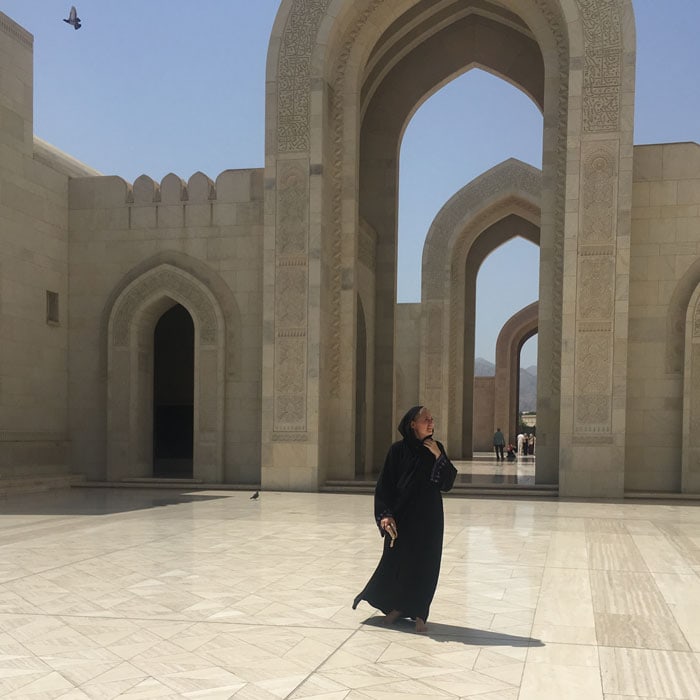

You can see for yourself the immense existence of this masterpiece of Islamic architecture in the midst of green flowering gardens along Sultan Qaboos Street in Wilayat Bawshar, an administrative district in Muscat Governorate. Every morning (except Fridays), the extravagant complex opens its doors to non-Muslims. Admission is free. Bend to the rules of strict access controls in advance and cover naked skin. Only the hands and feet may remain free from the ankles. Women are required to additionally cover their head hair and neck with a cloth. You can rent an Islamic abaya at the entrance. Your shoes must be removed before entering the prayer hall. If going barefoot makes you uncomfortable, just put socks over your toes before you head into the depths of Islamic religion.
Mutrah Souk
If more than a pair of dark, kindly beady eyes look curiously at you as you stroll through Muscat, a strangely bustling restlessness makes the strings inside you ring in joyful excitement, and a woody, balsamic scent laced with citrus notes beguiles your olfactory hairs, you have entered the largest and oldest Omani bazaar. The legendary Mutrah Souk has more than 200 years under its belt and was once a major transshipment point for trade goods, maneuvering cargo ships from all over the world into the port of Muscat.
Fragrant spices, fine fabrics and the finest jewelry were traded in the ancient souk and have lost none of their magic even today, despite the adaptation to the contemporary lifestyle of the Arabs. Follow the trail of billowing incense fumes through the seemingly endless maze of narrow streets, hear jasmine aromas hanging in the atmosphere and explore the scent tradition of Attar – perfume oils in high concentration.
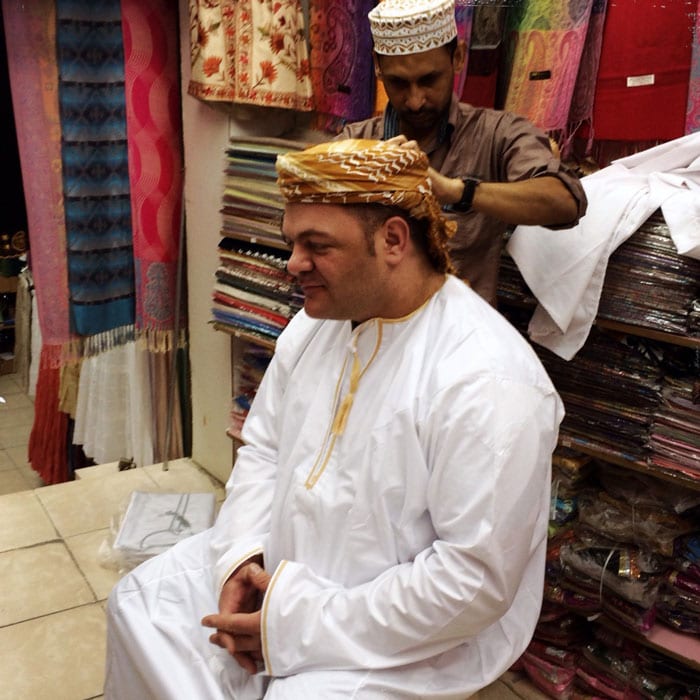
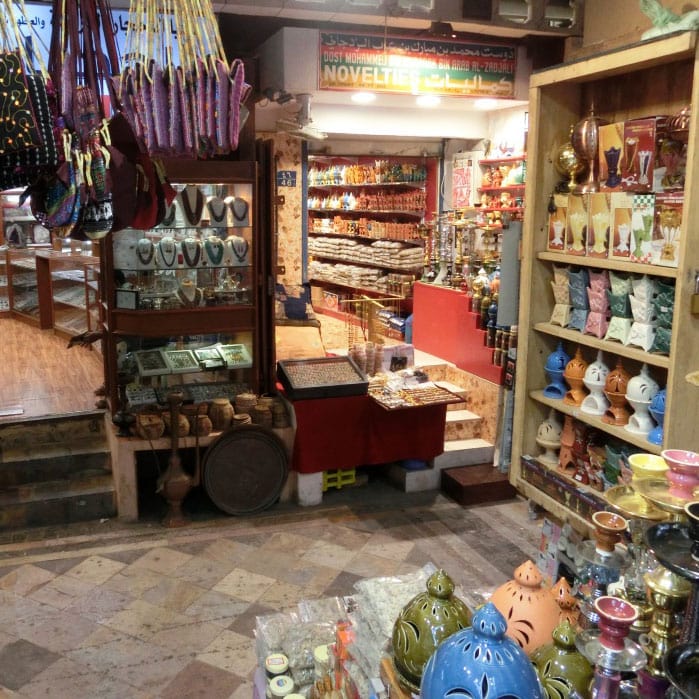
The mystical ambience of the old marketplace resulted not least from closely packed, clay-colored house facades. These were covered by palm leaves in those days and created corridors full of mystery. In the process, they achieved the welcome effect of providing locals with a shady refuge from the relentless force of the sun’s rays. Moving around in the dark was often only possible by means of lamps. Omanis therefore still affectionately call the Mutrah Souk “Al Dhalam Souq,” the Arabic variation of a shady market.
After a highly inspired team of architects gave the old souk a new aesthetic makeover, today you’ll wander through solidly roofed wooden structures while hookahs flute from the wayside for your valuables. In the boutique-like stores, in addition to the goods already traded in the ancient souk, buy fine incense of excellent quality, traditional handicrafts, dates, perfume and antiques.
Trading is expressly desired and makes the light of your eyes refracted in the stained glass windows shine many times brighter. You will find the Mutrah Souk very close to the port. Its fascinating corners are open every day for you. Afterwards, let your countless impressions sink in during a relaxed stroll along the Corniche promenade in Muscat’s elegant marina and enjoy the unique sight of the tangerine-colored cloths in the sunset light of anchored sailboats. Pure magic!
Al Alam Palace
Pure splendor as far as the eye can see. The palace of the reigning head of the Sultanate of Oman fulfills every demand of childhood dreams made flesh. The sky-blue-snow-white-gold shimmering symbiosis from Indian pens dates back to 1972 and is the pompous workplace of the Omani Sultan. The impressive building of the architectural master class was erected in the government district in the Anglo-Indian style and forms a charming contrast to the backdrop of the old town.
The two forts Mirani and Jalali, built in the 16th century, have taken the Al Alam Palace under their wing and hold their protective hands over the Sultan’s representative residence. The latter is present in the stately building for the purpose of state receptions. In addition, the building serves as a scenic composition for the “Tea Party” held annually on Oman’s National Day. Residence is in the district of Sib, about 30 km away, where the Sultan settled in the Bait al-Barakah Palace.
No matter how much your fingers itch, you can only admire the Al Alam Palace from the outside. Even entering the premises is strictly prohibited. Make sure your souvenir photo includes the richly ornamented fence made of forged iron. It provides a fitting frame for a snapshot and includes the shiny gold, mirrored coat of arms of Oman from the Said dynasty.
Enjoy the sight of the precious mosaics on the palace’s exterior façade and take a dip in the sun on the spacious, manicured forecourt. The alabaster-white, marble sidewalks bordering arcaded walkways and pitch-black, candelabra-shaped lanterns of the palace forecourt convey a similar energetic flair to that of the Yin and Yang teachings. A lovely floral fragrance of calyxes rising from flowerbeds will settle soulfully in your nose.
Fragrant idea for a dance through Arabian nights:
If you want to experience an especially fairytale moment, visit the Al Alam Palace in the evening hours. In this beautiful spot, you don’t need an artificially implied pastel filter for an atmospheric photo. The Omani sky alone gives you the most beautiful pastel tones that a sunset has to offer. Then spend the “Blue Hour” on the grounds of the Al Alam Palace.
It symbolizes the time after the sun has pulled its bedspread to the tip of its nose and before the Omani night sky sheds its inkwell. When the dark robe of night finally captures the palace along with the attached barracks of the Sultan’s bodyguard as well as the outbuildings, a magical veil of twinkling lights settles over the grounds. Capture the pearly iridescent glow of the Al Alam Palace in inspiring shots and disappear into the depths of the night. Maybe the scent of heaven is already leading you towards your must-see No. 4!
Royal Opera House Muscat
Whoever thinks of an oriental Muscat like from 1001 Nights most likely does not immediately have nasally bowed violin sounds and voluminous tuba tones in mind. But as strange as this idea may seem at first, the sight of the acoustically highly precise sound body is astounding. The sophisticated building made of rose-colored limestone towers with a melodramatic look in the Shati al-Qurm district on Al Kharjiyah Street near Sultan Qaboos Street on an area of about 80 hectares. Surely it will cast its incomparable spell on you even in daylight.
The Philharmonie made history when it opened in October 2011 as the Arabian Peninsula’s first opera house after four years of construction. It was built in the Italianate style inspired by Victorian architecture and embodies the spirit of the Omani Renaissance like few other buildings. The interior of the concert hall is paneled with dignified precious wood and the concert organ, which is mounted at a height of over 32 meters, is – who would have expected otherwise – from Bonn.
The red and gold ensemble offers pure philharmonic pleasure to an audience of 1,100. The royal box opposite the stage is reserved for the head of state, because the sultan is an enthusiastic fan of classical melodious sounds. Typical Arabic pointed arches adorn the impressive entrance and remind guests that they are still in Oman. Just walking across opulently laid marble floors feels like the suave, sophisticated gait of Omanis in their traditional Dishdasha garb.
It was Plácido Domingo who made not only the architects of the musical fairy-tale palace wince when Puccini’s opera “Turandot,” which he conducted, put the spatial sound to the test for the first time for an entire theater season. Since then, the world’s operas, musicals, plays and ballets have filled the concert hall with life, alternating with concerts by internationally renowned greats. If you want to experience the grandeur of a musical composition in the spheres of the Orient, you should not miss this unique and unforgettable experience of a visit to the Royal Opera House Muscat. You can buy tickets directly on the official website of the opera.
Be sure to follow the dress code no matter what type of event you attend at the opera. It is required as a formal or business dress code and includes a suit or jacket with fine trousers for men and a dress that reaches above the knees for women. Jeans, T-shirts and sneakers are considered frowned upon, will stop you from entering even just before you get there, and should definitely stay in your suitcase. At the Opera Galleria, which is directly adjacent to the opera house, you can dine on traditional Omani and international cuisine, as well as make your credit card glow in numerous stores.
If you are still fascinated by opera after a visit to a glamorous evening event, you have the opportunity to take a look behind the scenes of the Royal Opera House Muscat on a guided tour. These are offered daily in the morning between 08:30 and 10:30 and provide an interesting insight into the processes necessary to stage opera productions. Afterwards, you can chill out in style in the Opera’s stately landscaped garden, which is characterized by its oriental style, and enjoy a unique tranquility that is hard to find anywhere else in Muscat. No melody, no matter how emotionally moving, will sound more surreally real.
Brilliance has a name – nature & man-made cut diamonds around Muscat
Corniche
The sight could not be more beautiful and authentic. While Omanis wrapped in snow-white cotton sip a cup of coffee in the sun-protected pavilion, duel in a game of chess and let time be time, you join the pulse of life in a relaxed stroll along the promenade at the harbor. The promenade lies at the feet of the Mutrah Souk, stretching its limbs like waves for several kilometers and affording unique views of the impossibly ostentatious luxury yachts that the Gulf of Oman has pushed up to the quay.
“Forbidden Quarter” of Mutrah”
Surrounded by high walls, completely inaccessible to you, but no less charming, the Hellat Sur al-Lawatiyah district is entrenched behind whitewashed merchant houses. Al-Lawatia is the name of the Shiite sect that originated in Pakistan and, according to an inscription, moved to Oman in the 16th century. Residents born before 1970 still speak the sectarian language Lawati. Residents celebrate religious festivals, cultivate cultures, and typically live in close proximity to forts. Their own “fort” is barricaded to non-tribesmen, but worth a detour up to the trespassing tolerance limit. At the gates, sniff the mysterious aura that sublimely blends with that of the adjacent Mutrah Souk. A truly authentic testament to Oman’s religious tolerance.
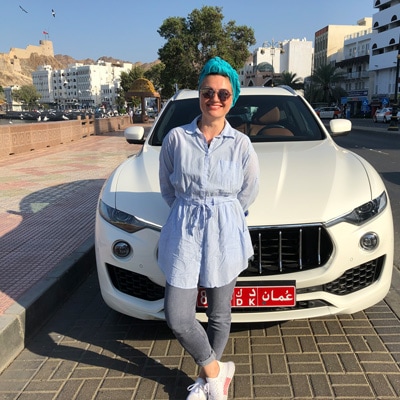
Mutrah Fort
Towering high above the eastern end of the harbor is the fortress built by the Portuguese around 1580. Three conical, cylindrical towers give the bulwark its typical silhouette, which has been widely admired by sailors. A robust flag waving in the wind catches stiff breezes and indicates where confidence is at home. Even if the fort is not accessible, it offers you the possibility of an excursion into Omani history. Even today, antique cannons are at home here. The very idea of this brute force grants an unadulterated, historical experience.
Fort Al Jalali & Fort Mirani
In old Muscat, the two 16th-century fortresses that today carefully watch over the well-being of the sultan’s palace Al Alam. Also known as Al Sharqiyah Fort, Al Jalali Fort and Mirani Fort known as Al Gharbiya Fort complete the trilogy of forces with Mutrah Fort. These bastions, too, can only be admired from the outside, but allow for a soothing time-out in the blissfully tranquil area under the watchful eye of the ocean.
Nizwa
You haven’t had enough of the country’s seemingly hundreds of bulwarks? Fortress mania or not – after about an hour and a half drive south, you won’t reach a mirage, but you will reach a real canon with the beautiful oasis town of Nizwa. The monstrous fort embodies Oman’s national heritage to perfection. You can find a detailed portrait of this altoman diamond here.
Sib
The largest wilaya in Muscat Governorate, Sib (also known as Seeb) nestles into the sinuous coastal terrain about 30 km west of Muscat in tune with the melody of the sea. Follow the sound of the ocean as your toes sink into the wet sands of Sib Beach, get a taste of the big wide world as you stroll through Japanese and Arabic gardens, and get an overview of the deep sea secrets that await you while diving in Oman at the Middle East’s largest aquarium, covering over 8,000 square meters.
In the 420-plus-acre Oman Botanic Garden, the melodic concept of sine waves continues in design and biodiversity. Experience unforgettable hours in harmony with the diamonds cut by the tears of Allah.
Daymaniyat Islands
No matter how many positions on earth nature has been sifted by pinpricks – on the archipelago off Sib and Barka it is still intact. Undestroyed coral reefs in the cocoon of nine small islets offer you with the nature reserve one of the most beautiful diving spots in the world and deepen the awareness that there is only one planet earth.
Nakhl
About halfway between Muscat and Nizwa, the al-Batina plain lies at your feet, characterized by an almost Elysian silence. The city slumbering in this plateau at the western tip of the Hajar Mountains gives the impression of being far from awakened from its slumber.
Nakhl Fort once served as a residence reserved for the imams of the Wadi Bani Kharus and Yaruba dynasties and was built organically around a rock created by Mother Nature. Who can claim to be set in stone? The scent of the surrounding lush date gardens gives you an experience for the senses that can only be topped by the hustle and bustle of the Friday goat market.
Is there anything else to complain about? With a little luck, you can experience the traditional way Omanis do their household chores in the adjacent Wadi Hammam. While the Ain A’Thawwarah hot springs bubble away leisurely, Berber women wave their laundry in the waters. Bathing is officially prohibited here.
Wadi Bani Khalid
At the opposite tip of the Hajar Mountains, a paradise that could not be more contrasting and refreshing welcomes you. If you are looking for the Garden of Eden, you should have found it here on the longest river in the Sultanate of Oman. Emerald pools ripple into natural freshwater basins that give the impression that the Omani gods have splashed a vibrant splash of color against the dusty, barren mountain cliffs. The perfect place to get another cap of fresh water for an upcoming hike.
Should you want to deviate from your hiking route because you are addicted to the wadi craze, you will find numerous other spring diamonds on your way back to Muscat with Wadi Tiwi, Wadi Shab, Wadi Al Arbeieen and Wadi Dayqah Dam.
Hiking in Omani mountain massifs
Before you indulge in the more strenuous activities in Muscat’s backlands, treat yourself to an epic trek in Oman. Taste the salty tears of Allah as sweat trickles down to your lower lip in the Hajjar Mountains as you battle the heights of Jebel Shams, and as you plod through the mountain villages lined with almond and olive groves on the Saiq Plateau in the Jebel Akhdar Mountains, where juicy mango, banana and apricot trees try to dissuade you from your route. In the elemental forces of Omani mountain massifs you will realize in a breathtaking way what it means to take on the gods of Oman.
Majlis al Jinn Cave
Located in the Salmah Plateau not far from Wadi Shab, the naturally formed grotto is the second largest underground cave chamber in the world. Gigantic 120 meters high, the dome curves over an area of 58,000 m² and a capacity of 4 million m³. The monster opened its maw in 2007 for a dangerous BASE jump by extreme athlete Felix Baumgartner and can only be legally explored by rope climbers. You should not get too close to the voracious abyss, because there is a serious danger to life! However, as a historical destination, Monster Cave is definitely worth a swing on the way to Bimmah Doline.
Bimmah sinkhole
Back to your fond emerald madness of the wadis, you’ll find the cratered Doline, separated from the Omani northeast coast by a paltry 600 meters. According to legend, it is the result of a meteorite smashed into sandstone. The salty terrain washed by the Gulf of Oman combines here with the sweet groundwater to create a fresh mix in which you can bathe your body. For an unadulterated underwater experience, you should stick your snorkel out of the tourmaline-colored water on weekdays at best.
Ras al-Jinz
Passing the characteristic Pebble Beach with its bizarre cave formations, you will make your way to the easternmost jag of Oman to the Ras al-Jinz Turtle Reserve. Under strict regulations of the nature conservation authorities you can explore the Turtle Beach exclusively with a guide, because the breeding area is the birthplace of numerous cute sea turtles.
Bathing on Omani picture book beaches
After this whirlpool of emotional experiences and physical challenges, you’ve really earned the jump into the cool water. Hang out at the granular sand diamonds Yitti Beach, Qurum Beach, Qantab Beach and Al Sifah Beach and stretch your tired muscles into the sun’s special treatment. When the solar tentacles kiss you at the tip of your nose, you can be sure that you have found paradise.
Muscat – hub for Oman’s trade routes
The moment when Muscat first appeared in the history books is shrouded in a fog that does not reveal a date. However, it is now believed that the important port and trade center dates back more than 2,000 years. Between the 7th and 16th centuries, trade relations with the Omani coastal cities developed so prosperously that Muscat was literally picked apart by Portuguese sailors in 1507.
With the focus of the Europeans on the coastline, the Omanis and the Sultan retreated to the mountainous outback of Oman and the regions around the Hajar Mountains experienced a real boom. Under Sultan ibn Saif I, Muscat finally succeeded in 1650 in driving the Portuguese from the coast and breathing new life into trade in the port.
After another backlash by the Persians, order returned in 1808 and the seaport was able to maintain its position for the first time. After political squabbles fragmented Oman into a coastal sultanate and a hinterland imamate in 1784, Muscat blossomed under the reigning Sultan Qaboos in 1971 into the capital of Oman as it is known today.
After Sultan Qaboos ousted his conservative father Said ibn Taimur and exiled him to London, the Omani Renaissance is now waving its magic wand and vigorously pushing modernization in all areas. Mission accomplished!
360° Emergency Compass for Muscat
- With a population of 1.5 million, Muscat more than lives up to its status as a capital city. As the largest metropolis, all threads converge here and Oman Air is also at home at Muscat Airport.
- The German Embassy is your contact point for all consular matters. You can reach them by phone at +968 2469 1218 or in person at the Diplomatic Area, Al-Khuwair, Jami’at Al-Duwal Al-Arabiah Street, Muscat.
- Don’t worry about medical care in Muscat! You will find them at the Royal Hospital not far from the Great Sultan Qaboos Mosque. The hospital can be reached by phone at +968 24 599000. Important: Take out international health insurance!
- You can reach the Royal Oman Police on Sultan Qaboos Street near the airport. Dial +968 24 521099, but in case of emergency, be sure to dial 9999.
- Jet through the urban jungle of Muscat with the comfortable fleet of Muscat Taxi Main Station. Call +968 9914 3222 to order your flying carpet deluxe.
Restaurants in Muscat – opulent excellence meets spirit of traditional country cuisine
Al Angham
The location alone, in the dramatic and gripping ambience of the Royal Opera House Muscat, promises glitz and glamour with a splash of grandeur. Authentic Omani heritage hangs lustily in every nook and cranny, creating an atmosphere that makes the conventional purpose of a restaurant visit to Opera Galleria almost obsolete.
Visiting one of the finest and most expensive establishments in Muscat, you will dine surrounded by the magical aura of Omani architecture, the likes of which have never been seen before in Oman. The charisma is even reflected in the brightly polished silverware, alongside teak paneling and artifacts from ancient Oman.
Your bottom will melt into the heavy velvet armchairs in private rooms and the exquisite service of the highest star cuisine will read your every wish from your ever-growing eyes. Experience a harmonious symphony of delights in the heart of Omani hospitality as the spirit of the present assimilates with the culinary legacies of the past.
If you want to enjoy your visit to the opera with all your senses, the Al Angham is an excellent choice, as it does not serve alcohol at all. Be sure to try one of the truly divine signature dishes of traditional oriental cuisine. O’rsyia, Harees, Jareesh and Shiwa are worth a real sin!
La Brasserie
In authentic ambience directly opposite the fish market you dine fresh fish cuisine par excellence. The upscale, mid-range restaurant, which serves European specialties and freshly caught seafood, will give you tongue puddles in a cozy atmosphere, complete with lounge sounds trickling in the background.
Dine eye to eye with epicurean beguiling lobsters gracefully draped on the finest porcelain, their claws at most anchoring your fine damask napkin. Shrimp soup offers you a fine entrée and a seafood crêpe is certainly what is commonly referred to as the “Dernier Cri”.
Eel yourself in the courteous service that matches the sincere charm of a bare-chested Frenchman and ponder once again how many diamonds in the rough the port metropolis in Oman has cut so far.
Shopping in Muscat – jingling cash registers put credit cards in a Valhalla mood
Theoretically, you could book a flight to Muscat just for the shopping. Because an extensive shopping trip to Muscat with all the facets that Oman’s store counters smugly offer you, takes a whole week of wondering, weighing, squinting at the account balance and then slamming it.
So what?! Nonchalantly whip out your credit card, use your plastic ticket to enter the eternal hunting grounds of the capital’s shopping madness, and discover the bold temptations that lurk in the whirlpool of Muscat’s thriving economy behind glossy glass fronts. Walk like the incense on daring soles through mystical souk corridors and contemplate the fabulous variety of precious goods stacked from floor to ceiling.
Surely they will coquettishly whisper “Come on, I’m worth it!” to you like the sound of sirens. Expect the temptation to go on a shopping binge to be disproportionately high on all corners of the city. With willpower and meticulous budget planning, nothing should stand in the way of looking, dreaming and being able to enjoy something. The following guide to the diverse shopping opportunities that the capital’s economy has to offer provides you with the right basis for this.
Ruwi Souk
If the hustle and bustle of Muttrah Souk is a bit overwhelming, but you still want to feel the real local color, but prefer it in a more intimate atmosphere, Ruwi Souk is a truly golden address for your inclined plans. You will find the ancient market in the village of Ruwi, which has retreated into the lap of the metropolis not far from Old Muscat and Muttrah.
Alongside finely knitted tailoring and luxurious goldware, your heart will beat faster at the sight of state-of-the-art electronics. A contradiction between the traditional souk life and the blessings of modernity that could not be more beautiful. The fastest and cheapest way to reach the souk is by public transport. Plan about two to three hours for your stay if you want to enjoy the feeling with skin and hair.
Omani Heritage Gallery
What the Moai are to the Easter Islands, traditional Omani craftsmanship is to your fondest travel memories. Immerse yourself in the world of fine arts and acquire heirlooms of the real Oman. In addition to intricately handcrafted beak jugs, basketry and silver jewelry, you can buy rugs handmade by Bedouin women of the Wahiba Sands desert and pottery from the northern Roman region of Bahla.
You’ll find the gallery in the Jawaharat A’Shati business complex in Shati Al-Qurum, the most expensive district Muscat has to offer. The art store is open a fabulous 24 hours and closed only on Saturdays. Let’s go! You won’t get the opportunity to bring home such elite souvenirs again so soon.
Amouage
Let the letters roll off your tongue one by one and feel all the pomp of the Orient unload on the fibrils of your nostrils. It is the liquid overkill under the sultan’s rule and the entire national pride of Oman. The state perfume sucks fresh rose water, lively myrrh and fine-spicy silver incense into a composition that will rob you not only the senses, but also the willpower mentioned at the beginning. The fact that the prices for the scent of the Orient are astronomical does not make things any better.
The mechanically applied scent of His Majesty can be physically paid homage to internationally exclusively in the posh fragrance houses of Harrods, Bergdorf Goodman, KaDeWe & Co. As “The Gift Of Kings”, the Arabic fragrance Amouage named after the “wave” is given away by the Sultan during state visits and is considered the most valuable perfume in the world. If you’re traveling without a political apostolate, the perfume factory in Muscat is your ultra-strong insider tip!
Feel how the vibrations of the fragrance molecules lingering in the air run riot on your nasal septum during a visit and witness how gently and lovingly the little perfume packets finally begin their journey into the world. For the bottles are provided with a personal, handwritten message from the factory workers, who are strictly segregated by gender.
During a guided tour you will learn valuable background knowledge. This way, you can simply let yourself be amazed and amazed without having to laboriously study explanatory charts. The Visitor’s Centre at Sib, a close distance from the airport and Al Sahwa Public Garden, is open daily except Fridays from 10 am to 10 pm.
Oman Avenues Mall
If the Amouage ecstasy hasn’t brought you to your knees yet and your credit card is still grinning at you encouragingly, give it your most gracious smile and take it out to Muscat’s biggest shopping temple. It towers over Sultan Qaboos Street with audacious nobility.
On an exorbitant 72,000 square meters, five floors and in 14 departments, a gush of 200 (luxury) labels pours into your wallet. Completing the elite lineup are a Gold Souk, revitalizing Food Nation and a Sky Lounge. Here you can indulge your shopping desires in full bloom every day between 9 a.m. and 11 p.m. and on Thursdays, Fridays and Saturdays from 9 a.m. to 11:30 p.m.
Hotels in Muscat – Overnight Chill in Splendid Style
The Chedi
If you don’t want to transport your suitcase and the empty copy for the souvenirs over tens of kilometers, the high-end establishment with its immediate proximity to the airport (15 minutes) is your top address in Muscat. In the sophisticated 5-star luxury house you can open your beach lounger directly at the terrace door and fold down your sunglasses from the hairline.
Club suites, deluxe rooms and superior rooms offer you all the comforts and a divine stay as if on a palanquin. You have direct access to the Gulf of Oman and after jumping into the cool water you can let yourself be toasted by the drumming of the rainforest shower. In two culinary soundscapes, four open-air gastronomic units, a lobby lounge and a shisha court, you’ll table like the Sultan.
Traditional Arabic, Asian and international cuisine are joined by fusion cuisine. At the Chedi Spa, you can get your well-deserved beauty sleep under the first-class pampering hands of the wellness team with holistic Ayurvedic treatments. He will be waiting for you behind the gate of your accommodation, when you drift into the realm of dreams in the purple light of the Omani nights.
Centara Muscat Hotel Oman
Not upper class, but middle class, you’ll stay in the nevertheless chic 4-star hotel in Al-Ghala, the city’s business district. It is also very close to the airport and the Oman Convention & Exhibition Centre.
By rental car you are at Athaiba Beach in about 10 minutes. This hotel is therefore only an option for you if you don’t want to commit to an immediate beach hotel. The heart of the elite house is the rooftop pool, from which you can enjoy a great view of the canyons while sipping a cup of Arabic coffee.
Feel the wind of the desert catching in your hair and the sound of the city bringing the melody of your heart to your ears during an evening pool session. Rooms, suites, gastronomy and spa are in no way inferior to the high Omani standard. Fish for you from the traditional Ocakbasi grill? The Turkish specialty restaurant “Akdeniz” roasts it crispy for you. But don’t worry: you’ll also be spoiled here with local dishes and food from the big wide world.
The only thing missing is the perfect sundowner in your hand, whispering the legends of the desert carried by the wind.
Muscat Inn Hotel
If you’re on a budget in Muscat or prefer to focus on Amouage & Co., the 3-star budget Muscat Inn Hotel is a reasonable option.
In only 6 minutes by car you are at the Great Sultan Qaboos Mosque. This puts the capital’s top sights within reach, and you can let the sound waves of the muezzin’s call tickle the tip of your nose in the morning. A day can’t start more beautifully and more typical of the country, can it?
Going out in Muscat – vibrant nightlife under the watchful eye of the wali
If you agree that it’s easier to stay awake until 6 a.m. than to get up at 6 a.m., Muscat offers a heat-filled, vibrant nightlife with the potential for surprises. Keep in mind, however, that in Oman it is best to respect the culture and hold back on alcoholic temptations.
That doesn’t mean you can’t happily sip a cocktail. However, even in extremely tolerant Muscat, exercise some caution in offering an Omani an alcoholic beverage. As a woman, avoid skirts that are too short and tight-fitting dresses if possible. As a man, long pants suit you better than shorts for nightlife.
If you are traveling as a couple, you are of course welcome to have each other. However, public displays of affection should be kept to a minimum. But enough of the sentimentalities: Take your organic straw, blow your desire for fun and fascination in cringes into the wind and let yourself be carried away by the irresistible pulse of the capital!
Rock Bottom Cafe
Want to know how the locals celebrate? The Rock Bottom Cafe in Qurum offers you a cultural symbiosis between Orient and Occident beyond the illustrious hotel landscapes. The nightclub is a popular meeting place for Muscat’s party crowd and a great opportunity to check out the dance moves of the Orient right on the floor.
Left Bank
Close to the Royal Opera House Muscat, on a hill in Shati Al-Qurum, the lounge bar Left Bank offers you hip hangouts and a fantastic view under the whisper of the wind. Chill with cool composure over a distinctive array of delectable cocktails and feel the vibes of the Orient tangle in your limbs. Rhythm is a dancer? Hell, yes! Mondays are Ladies Night and reservations are recommended.
O’Malley’s Irish Pub
Celebrate – how could you expect it otherwise here in the Orient – the Omani-Irish friendship with the Irish pub culture at the Radisson Blu Hotel in Muscat. Let a style Draught bubble down your throat and enjoy the cheerful atmosphere with attentive service. Afterwards, step into the night in a good mood and bask in the magical-abstruse sensation as the typical Irish sounds of tin whistle and Celtic harp still linger in your mind as your fevered cheeks collide with the heat-soaked night.
Special tips for an Oman experience in a class of its own – Muscat off the beaten tourist track
If you have already visited Oman several times or would like to experience something that you can hardly find in a travel catalog, the following grab bag offers you cute ideas for unique undertakings.
#1 Short distance – Kargeen – Cooking according to the culinary arts of the Omanis
Celebrate in Muscat in a stylishly exquisite way and show your loved ones back home where the wooden spoon hangs when you return! Because the Omani delicacies are pure fascination and far too good to be enjoyed only on the spot. Even if you like to indulge in pure indulgence while traveling, the sunlight-based endorphin influence may make you want to learn how to prepare the country’s typical specialties yourself. I
n the Kargeen restaurant, you and your travel entourage tie on your apron in the elite boho ambience. An Omani cook will introduce you to the traditional aromatic roots and delicate spices. Take a look at the recipe book, memorize the ingredients, and let your memory-filled, blissful smile flow into authentic Omani kitchen creations at home. A reservation in advance is essential.
#2 Long haul – Dhow Factory Sur – on the tracks of the legendary shipbuilding in the Middle East
About two hours away by car you will get the opportunity to visit one of the most legendary manufactories in the world. The dhow factory in Sur, southeast of Muscat, is the last of its kind in the Middle East. Here you can watch live and in color as craftsmen handcraft the magnificent, traditional sailing ships of Arabia with a great deal of skill, sweat and centuries-old tools.
Only a drill implies that the modern age has now also entered this industry. Witness on a tour how a genuine Omani dhow makes its way from pure muscle, teak from Burma and the desert tree ghaff into private collections and the commercial trade. This unique craftsmanship has its price! A fisherman today is not financially able to afford a dhow.
You will find the dhow building yard in the suburb of Al Ayjah. Drive past old merchant style houses in the port area and dive south into the world of legendary Omani shipbuilding on the western side of the Khor Al Batah suspension bridge. Admission is free and the mostly Indian workers usually willingly allow themselves to be photographed. However, a quick wellness check never hurts. In the factory store you can admire scale dhow models. Even if the stay is manageable in terms of time: it’s worth every second!

